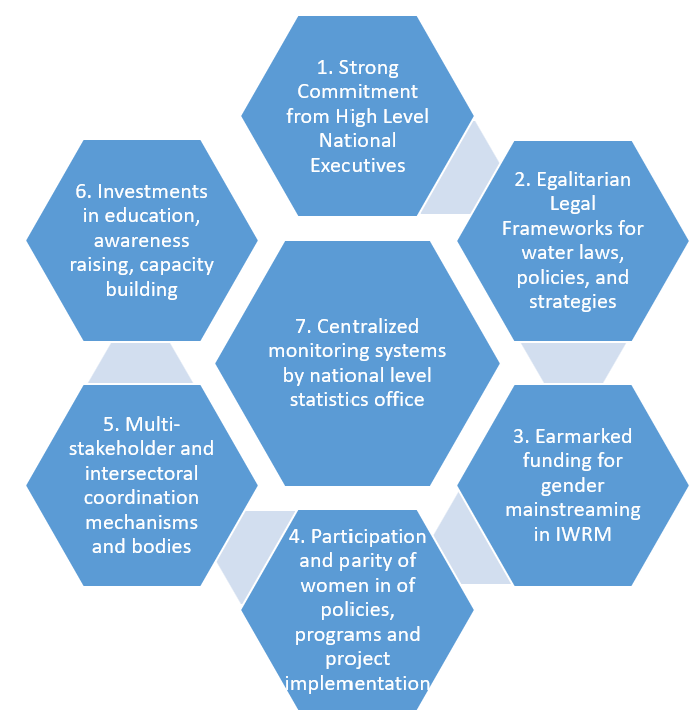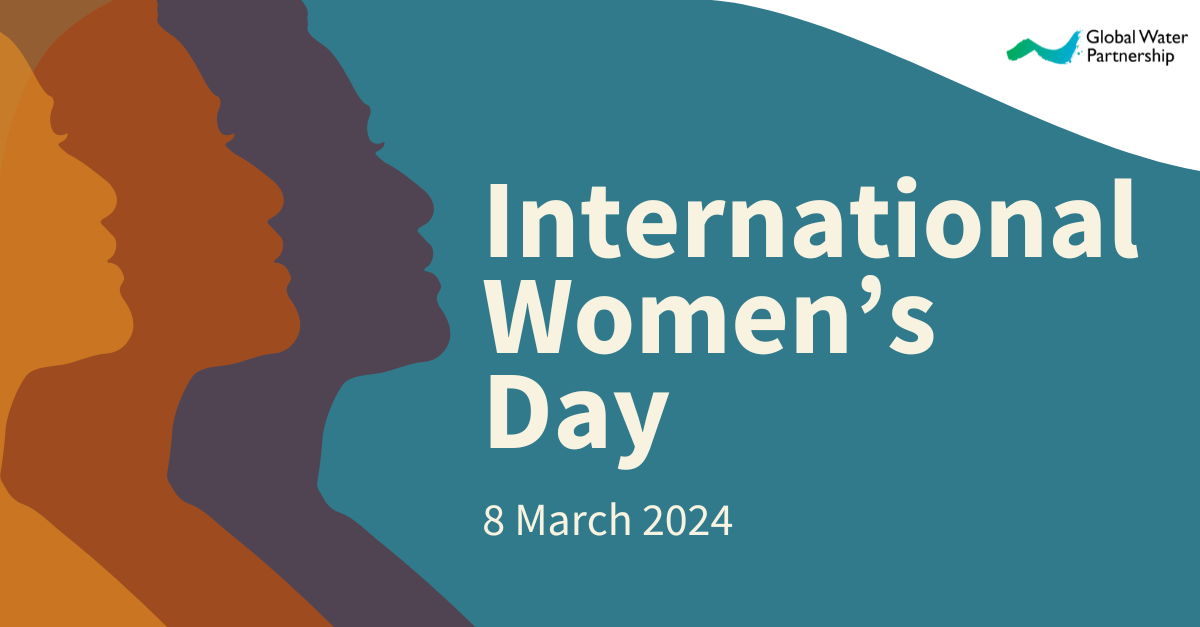Systems approach leading to change at scale | Support change on the ground | Spreading knowledge and facilitating learning | Invest in women: Accelerate progress | Call to action
Access to water – or the lack of it – has a profound impact on women’s lives. The task of fetching water is still largely a burden borne by girls and women in so many countries around the world. Whether or not that water is easily accessible is an important determining factor in improving livelihoods.
To illustrate, a World Bank study conducted in four countries showed that the availability and access to water have an enormous impact on girls’ education. Reducing the time needed to fetch water by just one hour increased girls’ enrollment in schools by 39% percent. You read that correctly: better access to water means better educated girls. Girls who are educated can compete for higher level jobs and those who choose to have children can break cycles of poverty as the children of educated women often fare better in school and have a higher accumulation of income throughout their life cycle.
The ripple effect of this one simple intervention – investing in access to water – will continue well beyond the girls’ own lifetimes, extending to every part of society and, indeed, future generations.
That is just one among many reasons that the Global Water Partnership (GWP), a network of over 3500 organisational partners in 180+ countries, is committed to gender mainstreaming in all aspects of water governance, management and investment. For GWP, inclusivity and gender equality have always been key values. Here is a short summary of what we are currently doing, and what we will continue to champion, as a central pillar of sustainable development.
Taking a systems approach to promoting gender equality, leading to change at scale
The four action areas from GWP’s Gender Action Piece provide the cornerstone for integrating gender equality in the work of our delivery network. Moreover, since 2020, a gender programme piloted in 8 African countries went a step further – to understand the underlying causes of gender inequality in water security and climate resilience, and address these root causes and barriers via politically supportable and administratively feasible entry points. The Africa Investment Programme’s flagship Gender Transformative Water, Climate, Development Programme (AIP WACDEP-G), was designed as an OECD Gender Marker 2 programme, considering gender equality a main objective of the programme, fundamental to its design and expected results, on par with water security, development, and climate resilience. The programme is expected to support and benefit 3.6 million people over the course of 6 years, and to influence $1 billion of gender equal and climate resilient investments from government and private sources.
WACDEP-G enabled the African Union Development Agency (AUDA) to develop a Water Investment Scorecard to integrate gender in assessing water governance and management capacity; actual expenditures of public, private, and donor money on water systems; and the wider investment climate for water. At the national level the Scorecard allows countries to track progress, identify bottlenecks, and take action to meet their targets for inclusive water investments. At the continental level, the annual progress reporting to Heads of States at the Africa Union facilitates countries to mobilize political support at the highest levels of government to ensure that gender equality is inherently enabled in the Africa’s race to close the 30 billion USD per year water investment gap.
Support change on the ground
GWP’s extensive global network of 77 country and 13 regional water partnerships work at all levels of gender mainstreaming efforts to support Integrated Water Resources Management (IWRM) implementation on the ground.
In 2021, GWP supported eight countries in Latin America, Bolivia, Chile, Costa Rica, Ecuador, El Salvador, Guatemala, Honduras, and Peru, to conduct a rapid analysis of the integration of gender issues in water and climate related policies, plans and legislation. The results were mapped on a scale that showed a range of gender integration among the countries, from 66% in Costa Rica to 22% in Honduras. This analysis enabled countries who are committed to this issue to have a baseline set of indicators, benchmark themselves against neighboring countries, and enabled them to identify priority and meaningful actions to improve the situation. With priority actions identified, GWP implemented an NDC Partnership-funded project to support the inclusion of gender considerations in Ecuador’s Nationally Determined Contributions, and worked with the Government of Paraguay to produce a Gender and Climate Change Communications Action Plan. In Guatemala, gender has been embedded in the IWRM Strategic Actions approved in 2023 by the Ministry of Environment.
Leverage that impact by spreading knowledge and facilitating learning
Knowhow from successful approaches around the world must be shared in order to expand capacity in other countries. GWP invests heavily in developing and spreading knowledge and technical advice for mainstreaming gender in the context of IWRM.
One of the most comprehensive and powerful knowledge tools available on GWP’s IWRM Action Hub is the GWP and UNEP-DHI publication, Advancing towards gender mainstreaming in water resource management. Published in 2021, and based on national responses to the gender-related question in the survey on Sustainable Development Goal (SDG) indicator 6.5.1 on the degree of implementation of IWRM, the publication identifies seven enablers to gender mainstreaming in water management, identifying cultural, legal and institutional barriers and opportunities.
Seven enablers for gender mainstreaming

Invest in women: Accelerate progress
This year’s International Women’s Day theme, ‘Invest in women: Accelerate progress’, highlights one of these key enablers for gender mainstreaming: the participation of women in forming and implementing policies, programmes, and projects. Women’s employment rates in the water sector have historically been low, owing to the popular belief that engineers (still a very male-dominated profession) were the most important to work in the water community, and that physical strength was a main criterion since the work involved heavy water pipes, construction, and installation machinery. Decades of advocacy and on-the-ground education, empowerment, and monitoring programmes have resulted in positive trends in women’s involvement in water management, which various studies have concluded in turn leads to an increase and effectiveness and efficiency of water system.
Water utilities have increasingly acknowledged the specific skills that women often bring as well-suited of the modern water utility. These utilities are evolving quickly as they become more customer oriented. Many are creating new departments to respond to emerging needs, mainly in client-facing areas such as customer service divisions. Because of technology and digitization, certain jobs no longer require physical strength. With the newest developments in artificial intelligence, leak detection, and new technological polymers and materials for pipe repair, utilities are identifying important employment needs to manage detection technology that does not put a premium on physical strength.
Of course, empowering women to get involved in water management is not enough on its own. Women must see the water sector as attractive for their individual career paths. More women managers and leaders must be appointed and visible to the ranks of new employees. And this is where the ripple effect of investing in women, water, and the world comes into play. While data in this important area tends to lag (which is a gender issue in itself), in a survey of 362 water utilities conducted by the World Bank in 2019, the percentage of women employed in those utilities rose from an average of 12% to almost 25% during a 5-year period. Furthermore, countries note their status regarding gender mainstreaming in water resources management through the SDG 6.5.1 survey, question 2.2(d), which has risen from 44% in 2017, to 54% in 2020, and now (hot off the press) to 58% in 2024. Good progress is being made, but not at the pace required to meet the 2030 goals.
Although there is more work to be done, progress like this is no accident. Women’s status in the water community is improving because gender has been acknowledged and highlighted as a priority issue in water management. Things are not moving fast enough for all women, however, and it is also lagging in related sectors. In the energy sector, for example, women account for only about 16% of the labor force. In general, progress in gender mainstreaming across all sectors is far too slow. According to the World Water Forum’s Global Gender Gap Report 2023, at the current rate of progress, it will take 169 years for the Economic Participation and Opportunity gender gap to disappear. While this is a terrible loss for women, it is also a critical and enormous economic loss to the entire world. In 2018, the World Bank estimated the scale of the loss due to gender inequality to be USD 160 trillion.
Call to action
While the road for women in water still has some ways to go, perhaps the strong arguments and signs of progress described above are something the water community should rally behind to inspire the rest of society. By prioritising the issue of gender mainstreaming, continuing to advocate for a gender transformative approach, sharing knowledge, driving changes on the ground, and increasing overall investment in the topic, we at GWP encourage the water community to be a source of ever bigger ripples that will grow to a wave of change and address the enormous, costly, and deeply unfair gender imbalances we still see today. Doing so may well be one of the best investments we can all make to achieve sustainable development – the world we actually want.
Alan AtKisson is Executive Secretary and CEO of the Global Water Partnership (GWP). Jaehyang So is global Chair of GWP’s Technical Committee.

